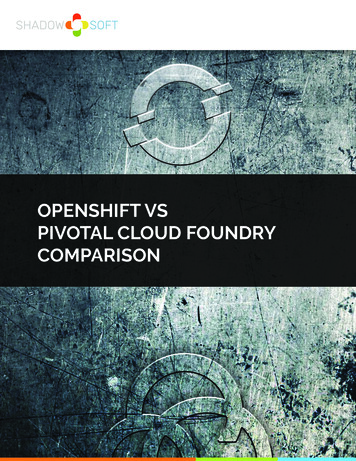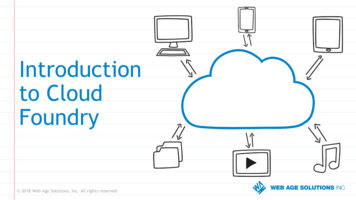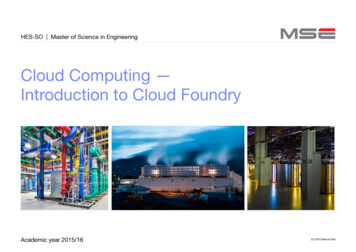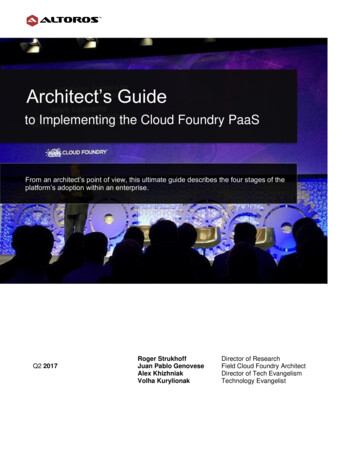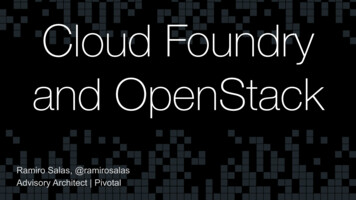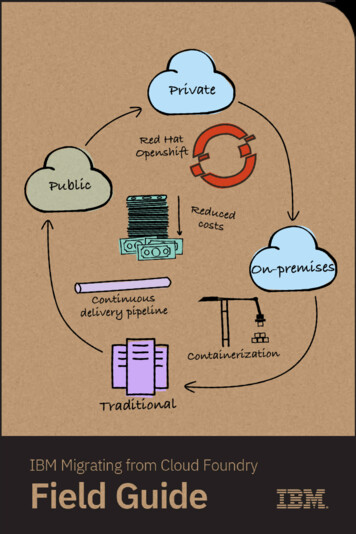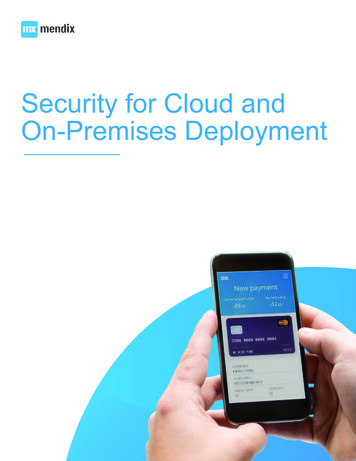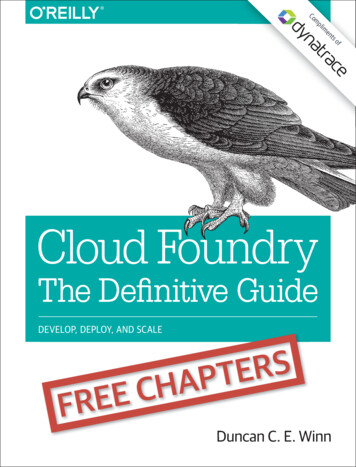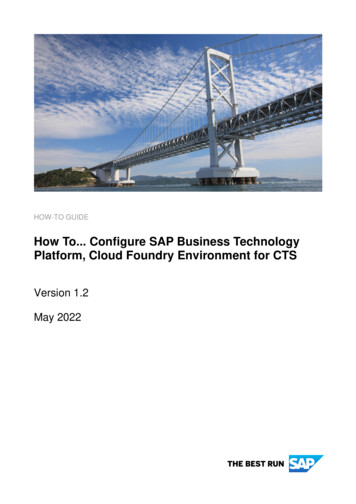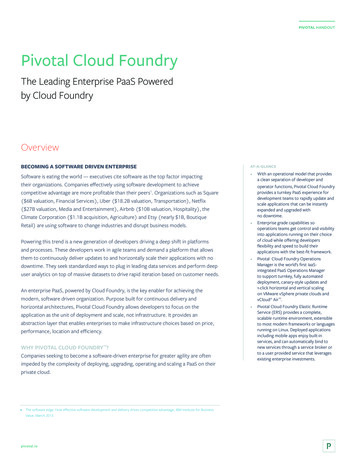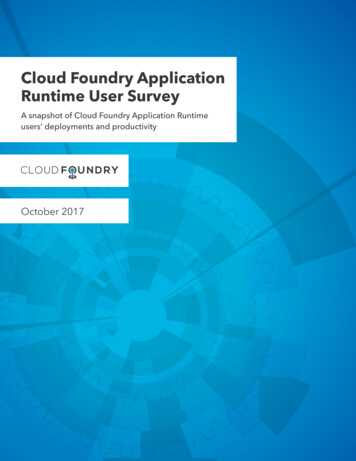
Transcription
Cloud Foundry ApplicationRuntime User SurveyA snapshot of Cloud Foundry Application Runtimeusers’ deployments and productivityOctober 2017
IntroductionCloud Foundry Application Runtime is a mature and growing cloud application platform usedby large enterprises to develop and deploy cloud-native applications, saving them significantamounts of time and resources. Enterprises benefit from the consistency of Cloud FoundryApplication Runtime across a variety of distributions of the platform, thanks to a certifiedprovider program.Cloud Foundry Application Runtime is a developer platform, first and foremost—and respondentsto the survey reflect this. A plurality (43 percent) of Cloud Foundry Application Runtime usersidentify as developers or “devops.” The next largest share is architects (31 percent), followed bymanagers, CIOs and other executives (18 percent), and finally operators (seven percent).Cloud Foundry Application Runtime Users43%31%DevelopersArchitects18%Managers,CIOs and otherexecutives7%OperatorsThe Cloud Foundry User Survey is the first in a series of semi-annual surveys conducted andproduced by ClearPath Strategies, a strategic consulting and research firm for the world’s leadersand progressive forces. For more details on Methodology, see page 13.Cloud Foundry Foundation Application Runtime User Survey2
Key findings from the survey include:1Freedom and Flexibility: Cloud Foundry Application Runtime is a developer-centricplatform, with 43 percent of survey user respondents identifying as a developer or havinga devops role. It is also closely associated with container usage, with half of Cloud Foundryusers currently using containers, such as Docker or rkt, with another 35 percent evaluatingor deploying containers.2Velocity and Productivity: Application development cycles go from weeks or monthsto hours and days. The percentage of user respondents who require over three monthsper app drops from 51 percent to 18 percent after deploying Cloud Foundry ApplicationRuntime, while the percentage of user respondents who require less than a week climbsfrom 16 percent to 46 percent once Cloud Foundry Application Runtime was deployed.3Maturity and Proliferation: Interest in Cloud Foundry Application Runtimecontinues to grow, even as existing deployments broaden within companies. Nearly half(45 percent) of Cloud Foundry Application Runtime users have only started with theplatform this year; more than half (51 percent) have more than 10 developers on CloudFoundry Application Runtime, including 28 percent with more than 50 developers onCloud Foundry Application Runtime.4Economy: Enterprise users ( 1 billion in annual revenue) report saving millions ofdollars on average per application development cycle.5Diversity: Cloud Foundry Application Runtime is deployed broadly across industries,including IT (47 percent) and financial services (19 percent).6Scalability: Nearly half (49 percent) of Cloud Foundry Application Runtime users arelarge enterprises ( 1 billion annual revenue).7Universality: Cloud Foundry Application Runtime is used globally, with just over half itsusers in North America (53 percent).Key Finding: Freedom and FlexibilityCloud Foundry Application Runtime is a developer-centric platform. For developers, it freesthem up to do more of what they want to do—code. For businesses, the benefit is more than just“happier developers.” The impact of Cloud Foundry is felt where it matters most—the bottom line.The shorter the time to market, the more immediate the benefits.Cloud Foundry Foundation Application Runtime User Survey3
Nearly 3X increase in developer productivityKey Finding: Velocity and ProductivityBusinesses running Cloud Foundry Application Runtime report significant savings—in both timeand money—as a direct result of building and deploying their applications on Cloud Foundry.Companies and organizations using Cloud Foundry Application Runtime enjoy significantly fasterapplication development cycles for their cloud-native applications. Prior to using Cloud FoundryApplication Runtime, typical users deployed and configured cloud applications manually (58percent), or used custom install scripts (52 percent) or configuration management tools (38percent), according to the survey.Pre-Cloud Foundry Deployment MethodsManual deployment & configuration58%Custom installation scripts52%Configuration management tools38%VM images27%Docker containers20%19%Linux packages4%Other0204060Cloud Foundry Foundation Application Runtime User Survey4
Under these workflows, a majority of respondents (51 percent) required more than three monthsto deploy a cloud application. Only 16 percent say it took them less than one week without CloudFoundry Application Runtime, including only six percent that could deploy a cloud application inless than one day.After moving those applications to Cloud Foundry Application Runtime, however, those timesdropped dramatically. Now, 46 percent of respondents report cloud app development cycles ofunder a week, including 25 percent who report it takes less than one day (increases of 30 and 19points, respectively). Using Cloud Foundry Application Runtime, only 18 percent of respondentsreport application development cycles over three months (a decrease of 33 percentage pointsfrom 51 percent).Pre- and Post-Cloud Foundry App Development CyclePre-CF30%15%Post-CF0015%19%Less than a day11%1-6 days5%1-3 weeks5%1-2 months-18%3-5 months-15%6 months 30%Cloud Foundry Foundation Application Runtime User Survey5
Cloud Foundry Application Runtime is maturing andgaining momentumCloud Foundry Application Runtime is a mature technology at nearly three years since thefounding of Cloud Foundry Foundation as the open source home for the platform. Althoughits history goes back even further, as it was originally incubated at VMware in 2010 and thenspun out as part of the launch of Pivotal in 2013. In 2015, the Cloud Foundry Foundation wasfounded. Global enterprises rely on Cloud Foundry Application Runtime every day to develop,deploy and manage their cloud-native applications. As more companies wade deeper intocloud, they look to Cloud Foundry Application Runtime and similar technologies to help themnavigate the waters.Key Finding: Maturity and ProliferationThis may explain why Cloud Foundry Application Runtime continues to see uptake from newenterprises and Small and Medium Enterprises (commonly referred to as the mid-market orSMEs). Nearly half (45 percent) of all Cloud Foundry Application Runtime users have beenusing the platform for less than a year, compared to 15 percent who have used it for morethan three years.Cloud Foundry Adoption LevelLess thana yearMore thanthree years45%15%Cloud Foundry isingly, the depth and breadth of Cloud Foundry engagement falls along similar lines.A plurality of Cloud Foundry Application Runtime users (61 percent) describe their deploymentsas somewhere in the early stages—trial, PoC, evaluation, or a partial integration into specificbusiness units. Meanwhile, 39 percent have deployed Cloud Foundry Application Runtimemore broadly across their company, from total integration in specific business groups tocompany-wide deployment.Cloud Foundry Foundation Application Runtime User Survey6
As companies increasingly leverage Cloud Foundry Application Runtime, they dedicate moreof their developers to developing and deploying cloud-native applications on Cloud Foundry.Currently, 51 percent of Cloud Foundry Application Runtime users have more than 10 developersusing Cloud Foundry Application Runtime, including 28 percent who have more than 50developers on Cloud Foundry Application Runtime. Many companies report massive developerengagement. Comcast, for example has more than 1500 developers using Cloud FoundryApplication Runtime daily. Home Depot reports more than 2500 developers.Developers Using Cloud Foundry Application Runtime10 or more50 or moreWe are also seeing developers at these companies increasingly “live” in Cloud FoundryApplication Runtime. Across all Cloud Foundry users, they report spending an average of 38percent of their days with Cloud Foundry Application Runtime-related tasks. Moreover, 36percent of Cloud Foundry Application Runtime users report spending at least half of their timeon Cloud Foundry Application Runtime-related tasks, with 16 percent spending three-quarters oftheir time or more on Cloud Foundry Application Runtime.Developers increasingly live in Cloud FoundryApplication Runtime. In fact, Comcast hasseen between 50 percent and 75 percentimprovement in productivity. That frees updevelopers to spend more time innovatingnew features and products.Cloud Foundry Foundation Application Runtime User Survey7
Interest in Cloud Foundry’sDeveloper CertificationProgram62%Interested42%Very InterestedThe large developer footprint of Cloud Foundry Application Runtime—especially within theenterprise—and the clear benefits of deployment at scale embed a strong interest in DeveloperCertification among respondents. A majority (62 percent) of users are interested in CloudFoundry’s Developer Certification Program, including 42 percent who are very interested.Key Finding: EconomyBy saving massive amounts of developer time, Cloud Foundry Application Runtime users alsosee return of financial resources as well. Enterprises that use Cloud Foundry Application Runtimeself-report savings in the millions per application development cycle, with some self-reporting inthe tens of millions. Savings generally tends to scale, both with deployment and size of company.For example, larger enterprises ( 50 billion revenue) report savings approaching 20 million inaggregate based on savings per development cycle, to-date.Creating Value:Cloud Foundry Application Runtimesaves business money and time.Savings after deploying Cloud Foundry Application Runtime is not limited to large enterprises,however. SMEs also report enjoying savings as a result of their Cloud Foundry ApplicationRuntime deployments. On average, SME Cloud Foundry Application Runtime users ( 1B) claimsavings of a quarter million dollars per app dev cycle.Cloud Foundry Foundation Application Runtime User Survey8
Containers and Cloud Foundry Application RuntimeThe flexibility of Cloud Foundry Application Runtime extends to orchestration andmanagement of Kubernetes. With the recent launch of Cloud Foundry Container Runtime,the Kubernetes-based container management project, Cloud Foundry Application Runtimecontinues to go hand-in-hand with containers. Half of Cloud Foundry Application Runtimeusers are currently using containers, such as Docker or rkt, with another 35 percent evaluatingor deploying containers.We are in the processof evaluating ordeploying containersYes, we arecurrently usingcontainersWe are not currentlyusing or planning touse containersMost Cloud Foundry Application Runtime users are using containers by virtue of managingtheir applications within a PaaS, either self- or provider-managed (59 percent). However, arounda quarter of users (26 percent) manage them with tools such as Kubernetes or Mesos, and 15percent manage them entirely DIY with in-house tools.How Cloud Foundry Application Runtime Users Manage Containers26%Self-managed PaaS(e.g., Cloud Foundry opensource, Red Hat OpenShift, etc.)34%Provider-managedservice(e.g., IBM Bluemix, PivotalWeb Services, AWS EC2, AzureContainer Service, GoogleContainer Engine, etc.)26%Self-managed usingorchestration tool(e.g., Kubernetes, DockerSwarm, Apache Mesos, etc.)14%Self-managedwithoutorchestration tool(i.e., do-it-yourself)Cloud Foundry Foundation Application Runtime User Survey9
The release of Cloud Foundry Container Runtime has generated significant interest amongCloud Foundry Application Runtime users. Nearly three-quarters (71 percent) of CloudFoundry Application Runtime users currently using or evaluating containers are interested inadding container orchestration and management to their Cloud Foundry ApplicationRuntime environment.Nearly three-quarters of Cloud FoundryApplication Runtime users who currentlyuse or are evaluating containers areinterested in adding container orchestrationand management to their Cloud FoundryApplication Runtime environment.A recent study published by the Foundation found that enterprise companies continue to wadegradually into container usage. For a more complete overview of findings about containers in theenterprise, read the 2017 Container Report.Cloud Foundry Foundation Application Runtime User Survey10
Challenges of Cloud FoundryA challenge to achieving the operational benefits of Cloud Foundry Application Runtimeusage continues to be the initial ramp-up time for the technology. As we have heard inprevious qualitative research, users in this survey report back on the difficulty getting startedwith Cloud Foundry Application Runtime. While the technology has made improvements inease of adoption over the past few years, user respondents report there is still the need forincreased simplicity in ramp-up.4.4Not so10AverageDifficultyA littledifficultVeryD i ff i c u l t yDifficulty Getting Started with Cloud Foundry Application Runtime48%17%35%12%Nevertheless, most users feel the time it takes to ramp up is worth it, as the direct benefitsabove indicate. An overwhelming majority of users (83 percent) would recommend CloudFoundry Application Runtime to a colleague, including 60 percent who would do sostrongly. Around one in 10 is more neutral toward Cloud Foundry Application Runtime, withonly six percent unlikely to recommend Cloud Foundry Application Runtime.User Likeliness to Recommend Cloud Foundry Application Runtime60%Would stronglyrecommend23%Would recommend12%Neutral6%Unlikely to recommendCloud Foundry Foundation Application Runtime User Survey11
Making the most of Cloud Foundry Application RuntimeCloud Foundry Application Runtime’s primary function for users is to develop, deploy andmanage their cloud-native applications. Among all users, an average of 30 percent of theircloud-native applications run on Cloud Foundry Application Runtime. As more companies rollout Cloud Foundry Application Runtime more broadly, the footprint continues to grow. Currently,46 percent of users have more than 10 apps deployed on Cloud Foundry Application Runtime,including 18 percent with over 100 (and eight percent with over 500).Number of Apps Deployed By Users onCloud Foundry Application Runtime54%22%6%10%1-10 apps11-50 apps51-100 apps4%4%101-500 apps501-1,000 apps 1,000 appsCompanies and organizations use Cloud Foundry Application Runtime to run a variety ofapplications. The primary use is for microservices (54 percent), followed by websites (38 percent),internal business applications (31 percent), Software-as-a-Service (SaaS) (27 percent) and legacysoftware (eight percent).Use of Cloud Foundry Application RuntimeMicroservicesWebsitesInternal business applications38%31%Software-as-a-ServiceLegacy software54%27%8%Cloud Foundry Foundation Application Runtime User Survey12
Users also enjoy the flexibility Cloud Foundry Application Runtime provides as the industrystandard cloud application platform. Whether companies come to Cloud Foundry early or late intheir cloud journey, the ability to run Cloud Foundry Application Runtime across multiple cloudsis critical to most users—60 percent say this is very important, and another 30 percent describe itas somewhat important.The reality supports this enthusiasm. More than half (53 percent) of Cloud Foundry ApplicationRuntime users run Cloud Foundry Application Runtime in a multi-cloud environment. Amazonleads the pack with 54 percent of Cloud Foundry Application Runtime users running AWS,followed by 40 percent on VMware’s vSphere, 30 percent on Microsoft’s Azure, 22 percent onOpenStack and 19 percent on Google Cloud Platform. A further 17 percent run on a variety ofprovider-managed PaaS, including Bluemix.Cloud Foundry Application Runtime in Multi-CloudUse reOpenStackGoogle CloudPlatform54%40%30%22%19%Demographics and MethodologyThe Cloud Foundry User Survey is the first in a series of semi-annual surveys conducted andproduced by ClearPath Strategies, a strategic consulting and research firm for the world’sleaders and progressive forces. User respondents were invited to take the survey from a varietyof sources, including Cloud Foundry Foundation emails, social media and direct membercommunications. A total of 735 user respondents completed the survey from 8/1/17-8/21/17.Who Uses Cloud Foundry?Cloud Foundry Application Runtime is a developer platform, first and foremost. The userrespondents to the survey reflect this. A plurality (43 percent) of user respondents identify asdevelopers or “devops.” The next largest share is architects (31 percent), followed by managers,CIOs and other executives (18 percent), and finally operators (seven percent).Cloud Foundry Foundation Application Runtime User Survey13
IndustryKey Finding: DiversityCloud Foundry Application Runtime users span a variety of industries, including heavyconcentrations in IT (hardware, software, services, etc.) and financial services, as well asheavy industry (automotive, primary goods, electronics, minerals, etc.), telecommunicationsand government.User IndustriesIT47%Financial Services19%(hardware, software, services, etc.)(banking, investment funds, insurance, real estate, etc.)Heavy industry5%Telecommunications / ISP / web hosting4%Government4%Healthcare and pharmaceuticals4%Non-financial services4%Transportation and logistics3%Wholsesale and retail2%Education2%Entertainment1%Light industry1%Infrastructure and construction1%Aerospace and defense1%(chemicals, primary goods, refining, electronics & automobile manufacturing, etc.)(national, state, municipal)(consulting, legal, accounting, logistics, hospitality, data)(consumer goods manufacturing, etc.)Non-profit 1%Utilities 1%Primary goods 1%(electric, water, sewer)(oil and gas, mining, agriculture, etc)Cloud Foundry Foundation Application Runtime User Survey14
Company SizeKey Finding: ScalabilityNearly half (49 percent) of all Cloud Foundry Application Runtime users are large enterprises( 1B revenue). A further 12 percent of Cloud Foundry Application Runtime users comefrom smaller enterprises ( 100M- 1B). The remaining 39 percent are from small and mediumbusinesses ( 100M).12%49%Small enterprises39%large enterprisessmall and mediumbusinessesGeographyKey Finding: UniversalityCloud Foundry Application Runtime users span the globe, though they are most heavilyconcentrated in North America, Europe and Asia. Nearly half (49 percent) of all Cloud FoundryApplication Runtime users are based in the US, comprising most of the 53 percent of NorthAmerican users. A further 28 percent are based in Europe, principally Germany (seven percent),the UK (six percent) and Switzerland (four percent). Asia represents another 15 percent ofCloud Foundry users, with Africa, the Middle East and Latin America rounding it out with fivepercent combined.28%53%EuropeNorth America 5%Latin America 5%Africa andMiddle East15%Asia and PacificCloud Foundry Foundation Application Runtime User Survey15
Additional Notes on MethodologyIn total, 735 user respondents completed the survey online. User respondents were invited toparticipate via Cloud Foundry Foundation emails, newsletters, Twitter, website and Slack channel,as well as direct invitation from certified platform providers and other members. Of the totalrespondents, 522 can be identified as “users.” Though companies who distribute commercialversions of Cloud Foundry could also be considered “users,” we exclude them from the analysisof this survey. Numbers may not add to 100 percent due to rounding, or for multi-responsequestions. Also, percentages in certain questions are calculated after excluding respondentswho chose to leave the question blank or refused to give a response. The Cloud Foundry UserSurvey outreach was delivered and the research instrument was drafted in English across allgeographies.Cloud Foundry Foundation Application Runtime User Survey16
Cloud Foundry Application Runtime is a developer platform, first and foremost—and respondents to the survey reflect this. A plurality (43 percent) of Cloud Foundry Application Runtime users . Cloud Foundry open source, Red Hat OpenShift, etc.) PrOVIDer-MAnAgeD SerVICe (e.g., IBM Bluemix, Pivotal Web Services, AWS EC2, Azure Container .
